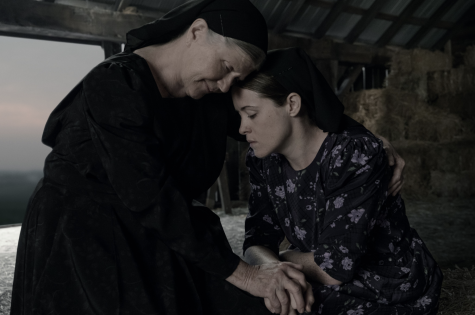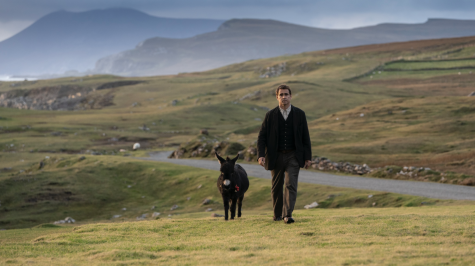A guide to the 2023 Best Picture nominees
March 17, 2023
“Top Gun: Maverick” 4/5
In 1986, Tony Scott blew everyone away with the iconic “Top Gun,” starring Tom Cruise and Val Kilmer. Nearly 40 years later, Cruise and Kilmer returned to dominate “Top Gun: Maverick,” which catches up with Cruise’s character Maverick, who is now a test pilot for the Navy after being an aviator for 30 years. Maverick is now training the Top Gun Flight School’s most skilled graduates.
The beauty of “Top Gun: Maverick” lies between the similarities and differences with its derivative. The 2022 version obviously has a more immersive action experience — there is rarely a dull moment when flying. The visual effects are impactful and the sound deeply enhances the auditory experience. The film would be a masterpiece on its own, but when its relation to the original “Top Gun” is considered, the movie becomes magical. Maverick’s heartfelt moments with Iceman (Kilmer) perfectly draw attention to their past without labeling the recent movie as just a sequel. Watching “Top Gun: Maverick” just felt good — that’s the easiest way to put it. The actors work together in a predictable and comforting way, the cinematography is well done and the dialogue is very purposeful.

“Women Talking” 4.5/5
Evidently, “Women Talking” is not an incredibly complicated premise or even title. However, its simplicity is its beauty. The women of a rural, religious colony meet to discuss the sexual abuse they had endured for years by the men with whom they lived. The survivors must decide whether to stay and fight or leave before the men return home.
In “Women Talking,” each individual’s process of healing and clarification is delicately conveyed through conversation, facial expression and connection to each other. The dedication to healing is what makes the movie so noteworthy. Yet, it may be the reason some have trouble connecting with this film. It’s been called “flat,” “uneventfully dull” and “whiny,” according to Google Reviews. Most films that address women suffering are noted because of their detailed description of that suffering. In “Women Talking,” the suffering is assumed and the reaction is described, a component that tends to be the critics’ least favorite part.
So, if you want to see an action movie consisting of abuse and trauma, then sure, skip “Women Talking.” But if you want to be guided through the minds of incredibly wise, yet repressed women, please give it a try. “Women Talking” elegantly tells the far too common story many women experience through an outstanding ensemble cast and an infinitely important message.
“Everything Everywhere All at Once” 4.5/5
Never before have everything bagels and taxes played such large roles in an Oscar-nominated film. They do, however, play a large role in many people’s everyday lives, including protagonist Evelyn Wang’s (Michelle Yeoh). Wang is a Chinese immigrant and mother who is summoned into the multiverse after an interdimensional catastrophe and is forced to utilize new hero-like powers to save everything, everywhere from the evil Jobu Tupaki, who is Wang’s daughter’s alter ego. Like its description, “Everything Everywhere All at Once” is both absurd and humorous, while somehow remaining philosophical and thought-provoking.
Wang battles seemingly every person she’s ever encountered while amidst her journey through dimensions, which opens her eyes to the decisions she’s made. “Everything Everywhere All at Once” uses this multidimensional factor to convey the message of the importance of appreciation of who you are and who you love. The film generally accomplishes this — some scenes, especially in the latter half, are chill-evoking and may even drag tears from a viewer’s eyes. Unfortunately, some of the heartfelt scenes get lost in the absurdity. Some may find it difficult to follow the point of the movie and instead become distracted by seemingly pointless subplots. If creators Daniel Kwan and Daniel Schenairt had more thoroughly integrated meaningful moments into ridiculousness or focused on the existing meaningful moments, the film may have landed better with some watchers. That said, the film would be nothing without its humor. The actors are phenomenal at combining laughter with inspiration and definitely guide the film to its praise. Even those who are hesitant to embark on a journey as unfamiliar as this should at least sit down and have a little fun.
“The Banshees of Inisherin”: 4/5

Released in October of 2022, “The Banshees of Inisherin” beautifully tells the story of overthinking in a friendship. (Image courtesy of Rotten Tomatoes)The value of kindness is oftentimes not conveyed through the friendship of two middle-aged Irish men. In this way, “the Banshees of Inisherin” is innovative. Pádraic Súilleabhá (Colin Farrell) is devastated when his best friend, Colm Doherty (Brendan Gleeson), decides to abandon their friendship one day due to Súilleabhá’s “dullness.” The film is essentially a dialectic of the emotional repression that occurs when a friend gets bored with another friend. Súilleabhá spends the duration of the film attempting to understand Doherty’s motivations.
There is nothing especially miraculous about this movie’s premise, which explains its four (fingers) out of five rating, in multiple ways. As previously stated, the plot isn’t particularly thrilling or philosophical. Yet, for some reason, it’s still incredibly engaging for the average person; “The Banshees of Inisherin” is largely praised because of its well-roundedness. Though it is a bit of a bummer, a hint of optimism frequently peeks through the melancholic tone. And, despite its sorrowful story, most scenes carry a sliver of humor, which allows for engagement. Both Farrell’s acting and eyebrows are also notable, as he exceeds previous expectations of the possibility of facial expression while the beauty of Ireland keeps viewers’ eyes stuck to the screen. And, the film’s lack of an inventive plot does not mean it is uneventful. Entertainment is not scarce as the plot progresses towards more and more surprising actions taken. “The Banshees of Inisherin” won’t be the most mind-tripping or action-packed movie you’ll watch this awards season, but it very possibly could be your favorite.
“Triangle of Sadness” 3/5
“Triangle of Sadness,” directed by Ruben Östlund, illustrates what happens when a social hierarchy is gradually flipped upside down. The film follows the relationship between influencers Yaya (Charlbi Dean Kriek) and Carl (Harris Dickinson) in a three-part structure. In part one, the audience is introduced to the shallowness that lies beneath the typical celebrity relationship. Parts two and three allow watchers to follow Carl and Yaya onto a luxury cruise filled with socialites and the uber-rich which, expectedly, leads to disaster.
Three very different words can be used to summarize “Triangle of Sadness:” fun, nausea and classism. One’s initial reaction to the film may be positive skepticism — Yaya and Carl present the audience with a glimpse into a world most are excluded from. I remained hopeful after the first part, as it wasn’t particularly enthralling but did present a lifestyle I was unfamiliar with. Most find people who are out-of-touch entertaining. Both the fun and the throwing up begin in the next section. The ridiculousness of two dozen millionaires being trapped in each other’s craze allows for quite a few laughs. The most comical scene is 30 minutes of the guests flailing amidst their seasickness while trying to compose themselves.
Östlund clearly mastered the combination of comedy and social commentary in “Triangle of Sadness.” The constant diminishing of the upper class and their obliviousness is entertaining, but unfortunately not funny enough to get one through the nearly 2 and a half hour-long film. “Triangle of Sadness” is a fun way to spend an evening, as long as you bring a barf bag.
“The Fabelmans” 5/5
Making a movie about making movies is a bold choice. Luckily, Steven Spielberg has the ability and right to do so. “The Fabelmans” is a coming-of-age story inspired by Spielberg’s childhood that follows Sammy Fabelman, who uses filmmaking to understand and tell the stories of the people around him. As Sammy deals with problems like familial betrayals, bullies and heartbreak, his passion for movies develops and becomes a tool to comprehend the things surrounding him.
Critics of “The Fabelmans” claim that Spielberg is coasting on his reputation. Sure, the movie may not have been as successful if it wasn’t followed by the Spielberg name. Yet, the relationship between protagonist Sammy and Spielberg is truly insignificant. And, it does not take away from the movie’s awe. It’s cheesy. It’s full of motivational quotes yearning to be repeated by the movie’s viewers. But I truly enjoyed every second. The acting is notably phenomenal, especially from Sammy’s mother (Michelle Williams), who dedicated herself to the role. The film also effectively portrays its era through music, setting and cinematography.
“Elvis” 4/5
Austin Butler’s portrayal of Elvis may go down in history as one of the most convincing performances of all time and for good reason. This biopic illustrates the story of Elvis and follows him through his astronomical career. Whether you’re an Elvis fanatic or simply someone who enjoys good music, “Elvis” is worth watching.
Director Baz Luhrmann excels in creating a film that successfully transforms time. Hair, music and setting ushers the audience back to the 50s and 60s. Each scene is pleasing to look at and decorated with momentums from the past. Butler adds to this with his voice and stage presence, which are both perfect replications of Elvis, explaining the connection many viewers have felt with the film.
However, that connection may begin to fade when nearing the end of the two-and-a-half-hour film. Unfortunately, “Elvis” is overstuffed with subplots and sometimes when a musical number occurs you might find yourself feeling thankful that an elongated scene of dialog has concluded. Despite its length, “Elvis” is a necessary watch. It’s emotionally thrilling, magical and incredibly entertaining.
“Tár” 3.5/5
“Tár” follows Lydia Tár (Cate Blanchett), a well-known composer-conductor as she works to elevate her career using the Berlin Symphony and receives reputation-damaging backlash about her personal life. Tár leans on her family while navigating the difficulties presented as a known figure in society. Some interpret the film as an attack on cancel culture. Others deem the cancellation justice.
“Tár’s” strongest appeal is Blanchett’s acting. In addition to conducting an orchestra, she can conduct a screen. She maintains a stern expression that only turns playful with her daughter, Petra (Mila Bogojevic), and her music. She has mastered the look of guilt while actively trying to deny she could ever be guilty of anything. By the movie’s end, one may be convinced that Blanchett was a former conductor reincarcerated into an actor.
Director Todd Field’s ability to meticulously piece together hints of a message in a subtle yet glaring way also provides to the film’s best picture nomination. He physically places characters that Tár believes are emotionally haunting her in precise locations throughout the film to let the viewer in on something Tár doesn’t know, offering Tár slices of vulnerability that she refused to let show.
“All Quiet on the Western Front” 3/5
“All Quiet on the Western Front,” based on the 1929 novel, follows Paul Bäumer (Felix Kammerer) as he enlists in World War I for the Germans and discovers the true trenches of war. Bäumer enters the war hopeful to emerge a hero but becomes increasingly devastated as he uncovers what it really means to be immersed in war.
In general, “All Quiet on the Western Front” is well done. It’s beautifully written and shot. The dialogue is impactful and ensures that each scene is meaningful. Kammerer delivers a moving performance — his acting phenomenally conveys the crossroads of guilt and determination. It’s obvious that Bäumer is naive and slightly innocent, but Kammerer’s acting allows the audience to obtain a glimpse at what war can do to someone like Bäumer.
While the film utilizes advanced filming techniques and is very cinematic, it falls short when delivering its message. Because “All Quiet on the Western Front” is based on an anti-war book from the 1920s, its effect has lessened. During the book’s time, media containing war material was rare, resulting in a jarred reaction from the audience. Now, because war is much more understood and accessible, war media doesn’t have the same effect. This means in order to be truly meaningful, war movies must do more than be well made. Unfortunately, “All Quiet on the Western Front” does not do more — besides its cast and cinematography, the film is not particularly special.
“Avatar: The Way of Water” 3.5/5
Similar to “Top Gun: Maverick,” “Avatar: The Way of Water” was highly anticipated because of the original film. 2009’s “Avatar” made a record-breaking $2.9 billion in box office profits and became the highest-grossing film of all time. “Avatar: the Way of Water” almost equated to those profits, earning $2.82 billion in box office profits, making it the third highest-grossing film. This success is generally for good reason. “Avatar: the Way of Water” is immersive and entertaining, but also very long.
Those who loved the original “Avatar” will love the new one. It contains all the favorite characters and jumps back into the life of Jake Sully (Sam Worthington) and Neytiri (Zoë Saldana) and their family in Pandora, following Jake as he fights against the threat of the humans. Watching the children developing similarities to their parents encourages the nostalgic tone present throughout the film. As expected, the technology and visual effects used are spectacular and enhance the watching experience, regardless of the storyline.
Those who only liked the original “Avatar” may be less likely to thoroughly enjoy its sequel. Despite its pockets of reminiscence and visually enthralling techniques, it’s difficult to ignore its length. Its duration, three hours and 12 minutes, taints the worthiness that lies within the plot. At times, your patience may be tested, and hitting the pause button seems easier than reaching the end. It seems like director James Cameron chose to ignore that entertainment and attachment to a storyline are irrelevant if the audience has to constantly pinch themselves to stay awake. Yet, those who are invested in what happens to Jake and Neytiri may be able to forgive its length and remain determined to absorb all “Avatar” material possible.
The 2023 Oscars were filled with captivating, cinema-altering movies that will leave long-lasting impressions on the film industry, and these 10 films are the champions of a significant year of movies. Understandably, most people can’t watch all of them. But, if you’re looking to add a few more movies to your repertoire, take the time to watch at least “Everything Everywhere All at Once,” “The Fabelmans” and “Women Talking.”























